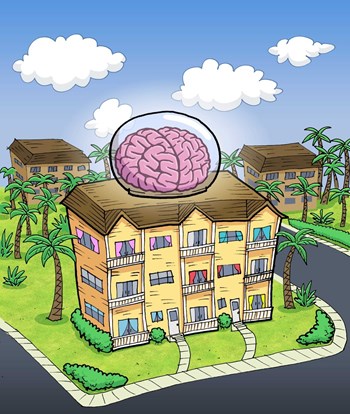
If phones can be “smart,” why not buildings? With the ever-expanding array of consumer technology available today, it should come as no surprise that residential buildings are incorporating more and more cutting-edge technology into their communications, security, and operating systems than ever before, and unifying building operating systems so they can be monitored and run from a central location by a building staff member, or by residents themselves with smartphones and iPads. Many of these innovative systems are being installed from square one in new construction, but also in the form of upgrades and retrofits in older buildings. Let’s take a look at the state of the industry.
“Unit integration means combining multiple subsystems together,” says Mark Goldman, president of Sound Components, a Coral Gables-based company that designs, sells and installs automation systems. “HVAC would be one subsystem, lighting control could be one, audio distribution could be another, security cameras could be another. So it’s putting all those things together on one unified interface. So the user will have one unified interface to view all of the different subsystems.”
Upgrading the Grid
“We have 4.6 million customers throughout Florida; we’re the largest utility provider in the state since 2009. We have been upgrading the electric grid and that includes intelligent smart meters in residences and commercial buildings throughout the state and the integration part of it is what we are improving,” says Florida Power and Light spokeswoman Kathleen Hinsdale. “With our smart meters, residential and commercial customers can log onto an energy dashboard. With this dashboard, the customer will be able to see how and when they are using energy. The dashboard is our way of putting the power back into the hands of the customer to inform them and educate them on how and where they are using electricity and hopefully make smart choices about energy usage. Our goal is to complete that by 2013,” she says.
Generally speaking, commercial buildings are more likely to be ahead of the curve with respect to systems integration, while residential buildings tend to be behind the curve. This is changing, however, as more and more boards are finding wisdom in investing in the new technology. At first blush, it would seem that the needs of both kinds of buildings are the same, but residential buildings have different needs.
According to Hinsdale, in the state of Florida, more modern building codes have evolved in commercial buildings as opposed to residential buildings, which may explain why commercial buildings may have a leg up over residential buildings in terms of systems integration, but not everyone agrees.
“It’s not necessarily true that commercial buildings tend to be more state of the art in terms of integration than residential buildings,” adds Goldman. “Within any particular unit you could have many subsystems and in a condominium you might also have pool, spa and outdoor lighting that could be integrated.”
“Intelligent buildings typically tie together multiple, disparate systems,” says Rawlson King, communications director of the Continental Automated Buildings Association, a 20-year-old international industry association, composed of about 350 corporate members. CABA is dedicated to the advancement of intelligent home and intelligent building technologies. “In fact, it can be argued,” says King, “that intelligent buildings transcend integration to achieve interaction so that previously independent systems work collectively to optimize building performance, including monitoring comfort levels, security systems, energy systems and operations.”
Integration and interaction are what drive intelligent buildings. But what does that mean, and how does it work?
“Building automation systems and building energy management systems”—BAS and BEMS, respectively—“are designed to provide centralized oversight and remote control over heating, ventilation and air conditioning (HVAC) systems, lighting and other building systems,” King explains. “In simple terms, a BAS is a programmed, computerized network of electronic devices that are employed for control and monitoring of systems. It primarily aims at optimizing the performance, start-up and maintenance of systems and greatly reduces the interaction of mechanical subsystems in a building. BEMS basically performs the same functions as a BAS but varies more in capability and functionality.”
Sophisticated Building Systems
These systems carry out a host of functions, King says, including optimization of stop-and-start systems, maintenance scheduling, alarm generation, and constant monitoring of the whole integrated system.
“BAS and BEMS vary in capability and functionality, but typically consist of sensors, controllers, actuators and software,” he says. “Depending on whether a human-in-the-loop factor is involved, decisions are taken manually or by utilizing embedded intelligence such as decision-making algorithms.”
Technology, as the futurist Ray Kurzweil points out in his books, is progressing exponentially. Intelligent buildings are no exception. What began with modest advances is now capable of astonishing feats.
“The origin of system integration or interfacing started with fire systems triggering reactions from other related building systems; HVAC, access control, elevators, etc.,” explains Jim Sinopoli, managing principal of Smart Buildings LLC, which maintains offices in Florida, Texas and North Carolina. “Today system integration includes all of the control systems in a building, but also encompasses facility management systems, business systems, and eventually, utility grids.”
“Traditionally, building systems had been characterized by highly proprietary offerings with limited ability to inter-operate,” King says. “As an example, in the 1950s, control over a commercial building's lighting systems and heating and air conditioning would have been separate functions, probably maintained by separate personnel. With the advent of computer systems being integrated into buildings in the late 1980s and early 1990s, such building systems could be centrally controlled”—that is, integrated.
Once that was achieved, the technology flourished. “With the advent of open networking and the Internet, now systems can be controlled remotely, and building operations across a whole building portfolio can be centralized in one regional control center,” King says.
Of course, just because something is possible doesn’t mean everyone is doing it; contrary to popular belief, not everyone tweets or is on Facebook. “I don’t think the average building today is operating that differently today than in was, say, 50 years ago,” says Goldman, “Even though all of this technology is available.”
Of particular interest to residential buildings, with their multiple entries (front door, laundry, common rooms, roof, etc.), is what experts call “key security.” The challenge of keeping emergency copies of owners’ apartment keys in a totally secure environment (so as to prevent employee theft or other unauthorized access) while at the same time providing quick emergency access 24/7. Twenty-five years ago, there was no system at all for this, and now there are two: Keytrack and KeyLink. These are highly sophisticated lockbox biometrically-operated systems, uniquely used by residential high-rise buildings, auto-dealerships, and the U.S. military in Iraq.
As Sinopoli points out, “the idea of integration automation is driven by the owner”—that is, the board and the residents. If there is no push to update the systems—or, in new construction, implement them correctly—the technology is useless.
The prices of systems vary and depend on the particular needs of the user. “If you were talking about a 6,000-square-foot condo and you were going to go in and do shade control, lighting control, install televisions throughout the unit and HVAC integration, you’d probably be looking at three weeks with a two man crew start to finish,” says Goldman. “Including programming it would probably be between $15,000 and $25,000 for labor and if you add the cost of the equipment with an automated system the cost could easily be $100,000 on up.”
The Wave of the Future
“If current trends continue, by 2025, buildings worldwide will be the largest consumers of global energy, using as much power as the transportation and industrial sectors combined,” says King. “Recent studies have found that improving energy efficiency in buildings is the least costly way to reduce a large quantity of carbon emissions. By changing energy management practices and instituting technologies that enhance energy efficiency, building owners and managers can reduce energy consumption by up to 35 percent.”
Is a 35 percent reduction in energy costs worth the $4,000-a-year bill? Perhaps. This is the wave of the future. More and more buildings will be upgrading and using more advanced technologies.
“In an era of volatile energy prices and increasing concern over climate change, the need for the innovative application of technology has become highly acute,” says King. “Buildings with integrated intelligent building technologies can save thousands and even millions of dollars in energy by delivering heating, cooling and lighting more efficiently. Intelligent buildings are increasingly using solar walls to capture energy from the sun, ventilation systems to recapture and reuse heat, insulation strategies that enable better climate control, high-efficiency lighting systems that enhance illumination with less electricity and automatic systems that control building services based on activity.”
Hinsdale believes that smart buildings and technology are part of Florida’s future. “We are definitely building a foundation of smart technology for the future,” she says. “In the future FPL customers will be able to purchase smart appliances.”
Greg Olear is a freelance writer and a frequent contributor to The South Florida Cooperator. Staff Writer Christy Smith-Sloman contributed to this article.






Leave a Comment